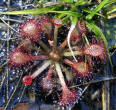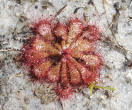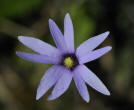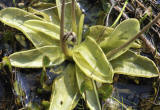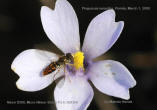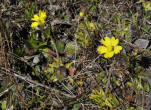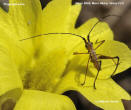Carnivorous Plants:
|
Classification
Phylogeny World Map Illustrations References |
| CP Book Library |
| CP Web Links |
2008-March-28
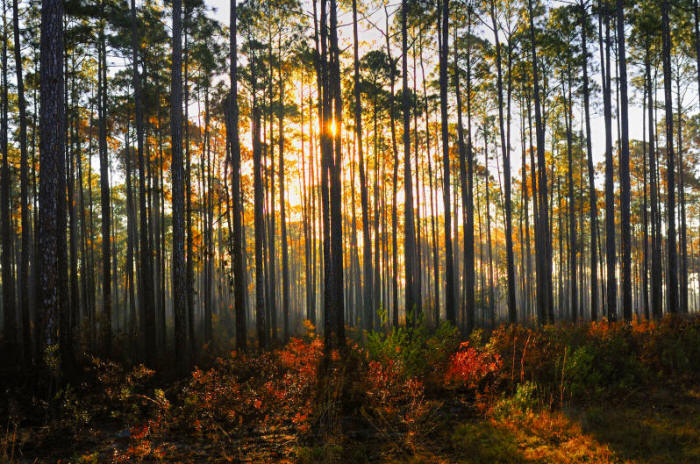
Morning sun pierces through the pipe forest, Florida. March 1, 2008.
I visited the southeastern part of the United States on Feb.28 - March 3, 2008. My last trip to this area was some 29 years ago. Timing of this trip tells you that the main purpose of this adventure was to observe blossoming temperate Pinguicula species growing in this region of the Gulf Coast. During my trip to the Florida panhandle on almost the same period (2/28-3/6) in the year 1979, I was able to observe the early-spring blossoms of P. lutea, P. caerulea, P. planifolia, P. ionantha and P. pumila. The only species I could not find (even in my previous summer trips) was P. primuliflora. Somehow this species eluded discovery.
Also on my agenda in this 2008 trip was to survey the area for pitcher plants that I may be able to see and photograph come spring. I flew to Mobile, Alabama (from LAX) using American Airlines. I had to stop over at Dallas/Ft. Worth. Leaving home early in the morning of Feb. 28 (at 3:00am) to catch a 6:30am flight, I arrived at Mobile Regional Airport around 3:00pm local time. Getting a mid-size rental at National, I headed east. I also rented a GPS gear with my car, which came in very handy during the drive in the Florida panhandle. The GPS was a small Garmin model. With ten bucks a day, probably it's much cheaper in a long run to get one from Best Buy. One of our family cars has a navigation system and the screen is four times bigger than this Garmin model, but this portable one was very useful.
As I started driving heading east, past the Florida-Alabama border, it became painfully obvious that the American southeast, once the Mecca of US carnivorous plants, home of many a pitcher plant and butterwort species, is no more. A powerful force of economy in Florida pushed the development, converting large areas of wetlands into high-rise construction.
For the first day, in spite of my frantic search, I could not find any carnivorous plants. In fact, it is more accurate to say that I could not find any place in which to search for carnivorous plants. I felt exhausted, feeling kind of ridiculous trying to find CPs in the midst of the city of concrete and highrises.
Not to disappoint visitors to my site very much, I did find some CPs on the second day onwards after careful searches of various spots recorded on the decades-old notes on my past CP trips. However, catastrophic destructions of habitats for Sarracenia and other carnivorous plants in the Florida panhandle region is a reality. I was planning to visit this area again in spring to see some pitcher plants.... but I could not locate any field where the pitcher plants might grow.
2008 March - Carnivorous Plants Found In Florida panhandle
I found the following carnivorous plants and managed to take some pictures in their natural environments. Luckily for the few days I was in Florida, the weather was nice and sunny, and very comfortable. I did not encounter any showers, flooding and storms, that are not uncommon in the region. (I heard on the news after my return to Los Angeles that a tornado might have hit Tallahassee a day or so after I left Florida.) Even so, I was bitten countless times by very nasty and aggressive mosquitoes while holding the camera in the field. I was wearing a pair of pants (long) and a heavy shirts with long sleeves. Beside my hands, the only exposed area of my body was my face. Yep, that's where the mosquitoes got me.
Utricularia inflata
This is the first carnivorous plant I found in this trip. I think it was U. inflata but could have been some other species. The main stem was 1 m long and a few branching stems growing from it. The plants were growing in the ditch. There was no flowers yet.
Sarracenia psittacina
Many plants were seen on the ground where the pine forest ends. Inside the forest is probably too dark for the pitcher plants. The rosette diameter ranges from 5 to 15 cm. Because of the forest fire (controlled burn by the forest service), some pitcher leaves were half burned, but the rosette center retained a healthy green bud. No flower buds were seen yet.
Drosera filiformis
Intermingled with Sarracenia psittacina, there were many D. filiformis, both pure green var. tracyi and reddish var. filiformis, growing sympatrically. They were just coming out of winter hibernacula, growing an inch or two of new glandular leaves. These also had endured the heat of burn on the ground surface.
Drosera capillaris
On the moist grass-covered surface and on the pure white sand, I found many D. capillaris, many of them an inch or so in rosette diameter but some reaching two inches. The plants were reddish. Some had flower stems just coming out. Some were found in standing water, but this may be just temporary.
Drosera brevifolia
On the same moist white sand surface where D. capillaris grows, I found tinier sundews very similar to D. capillaris. The leaf color is also bright red. The absence of a clearly defined leaf stem identifies this sundew as D. brevifolia. Though less numerous than D. capillaris, I found quite a few D. brevifolia plants on the sand surface. Many had an emerging flower bud in the rosette center. In some places these species were growing side by side. I would not be surprised to find natural hybrids of these sundews.
Pinguicula lutea
I saw several colonies of Pinguicula lutea. Yellow blossoms were spectacular and most noticeable among all pings. The early March is the height of their blossoms. Some flowers measured 3 cm across or more. A gentle breeze shook the yellow flower violently held high on a tall scape, especially when I was holding the camera to focus. Attacks from the blood-thirsty mosquitoes were nothing but merciless, even in a broad daylight. Flowers open fully and widely only under bright sunlight. Petals close somewhat in the evening and open again next day around 9 am.
Pinguicula caerulea
I did not see any Pinguicula caerulea which bears purple flowers. (The vegetative part of the plant is indistinguishable from that of P. lutea.) I later realized I did not travel deep enough to the east into the Florida panhandle to reach their distribution range in Florida.
Pinguicula ionantha
This is a species with very limited distribution. And very endangered. I was able to locate several colonies of this rare species. Just as I expected, the plants were blooming very nicely. In this species, flowers open widely and fully only for a few hours of the day. Although the same flower seems to last for several days, the petals start to open fully around 9 AM on a sunny day, and remain open until 2 PM before starting to close for the night. The first day I found the plants, it was 4 PM in the evening, and the flowers were not fully open. I had to come back to the same site next day to photograph the flowers. Even in flower, P. ionantha is not an easy butterwort to find in nature. If you miss this period of a few hours when the flower is fully open, or if the day is cloudy, tiny flowers of P. ionantha are not at all noticeable, well hidden and mingled in the tall grasses covering the wet surface.
Pinguicula planifolia
I was wondering where P. planifolia had gone after having found a rarer P. ionantha species. I would have thought that somewhat larger flowers of P. planifolia, not to mention the redness of their leaves, made it easier to locate this species. After some unsuccessful searches, I even thought the reddish vegetative part of the plants might have made the plants an easier target from poachers. Then, there it was, just in front of my feet, I noticed a purplish flower. This species also requires strong sunlight to open the flower fully.
Pinguicula pumila
I had seen this small butterwort many times in the past, both in flower and out of flower. This time, I somehow missed P. pumila. Some plants growing along P. ionantha but without flowers might have been P. pumila, but I doubt it. This is not a rare Pinguicula at all in the Florida region. That does not mean the plants cover the entire Florida grassland. You have to look for them. Perhaps I did not look hard enough....
Pinguicula primuliflora
In this trip once again, I could not find this species. This remains the only species out of six temperate Pinguicula in the southeast wetlands that I have not seen yet in the wild. At one point in the trip I got so excited upon encountering a butterwort colony - thinking that it was P. primuliflora. It turned out to be a colony of P. ionantha, a species far rarer than P. primuliflora in the region. I got confused as to how to distinguish P. ionantha and P. primuliflora flowers in the field... possibly due to a large amount of blood loss to Florida mosquitoes. After all, these two flowers are very similar in shape, though having different corolla coloration.
Carnivorous Plants Photography....
Obviously, 29 years ago, there was no usable digital camera to speak of. I was using good old Kodachrome-25 transparencies from Eastman Kodak. In shooting Pinguicula flowers in the field in 2008, I was reminded of how narrow the dynamic range of the digital sensor is. The "dynamic range" is a new jargon referring to what we used to call the "latitude" of a film. I had to check the LCD monitor on the back of my camera religiously to ensure the highlights of the flower was not lost in the image file. Even with the Nikon D300's Active D-Lighting enabled at the highest setting, the brightness of a P.ionantha's white flower could not be contained in the range. I often had to apply manual exposure compensation reaching full two stops.
Besides technical aspects of digital photography, Pinguicula is a very difficult subject to photograph. The plants are small , and flat, often buried in the surrounding vegetation. To make the situation worse, taking pictures of blooming Pinguicula presents additional challenges of how to focus on both flowers and leaves. No, I do not own a PC (perspective control) lens that allows "tilt" operations as in a view camera. Nikon offers a solution with their newly announced PC-E Nikkor 24mm F3.5D ED for mere $3000. Well, using the web, you can get one for less than two grand from Adorama - if you are so motivated.
In this 2008 trip, I took over1000 CP photographs. In the photo images presented below, you will see the result of my struggles to capture tiny butterworts blooming in the Florida wetlands.
Pinguicula ionantha A bee on a flower
Pinguicula lutea A bug on a flower
On this trip I
took a
Nikon D300, two 8GB and two 2GB CF memory cards. I also used a Nikon
angle-viewfinder.
Lenses used are: Nikkor 16mm F3.5, Nikkor 20mm F3,5, Micro Nikkor 55mm
F2.8, Micro Nikkor 105mm F2.8, Nikkor 180mm F2.8 and AF Nikkor 18-200mm
F3.5-5.6.
| Carnivorous Plants Photography Web Site: Copyright © 2001-2018 Makoto Honda. All Rights Reserved. |

